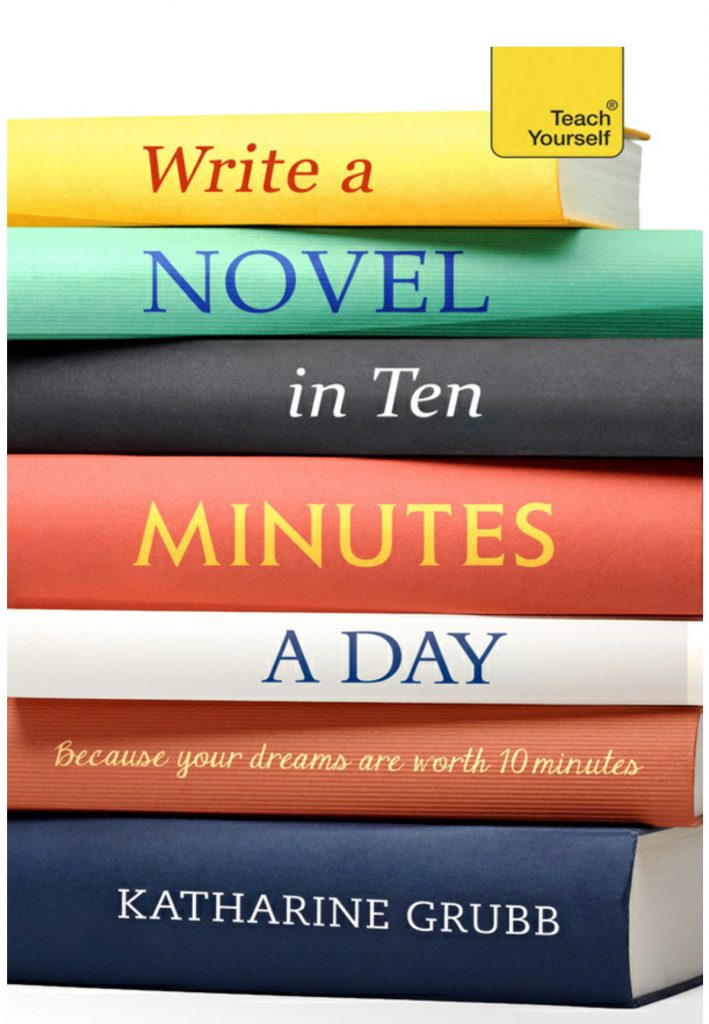It’s been a while coming, but I am finally ready to write my review on Katharine Grubb’s book, Write a Novel in Ten Minutes a Day. Why has it taking me so long? Well, firstly, I was trying write my novel following her methodology, and then I got a bit sidetracked by NaNoWriMo. But here we are, finally.
This page contains affiliate or referral links, which means I receive a small commission if you decide to click through and buy anything. This is at no extra cost to you, but helps me maintain this website 🙂 If you want to know more, please read our Affiliate Disclosure.
I do love Grubb’s book Write a Novel in Ten Minutes a Day, and would definitely recommend it to everyone, and especially the busy writer. Even reading it only for the first section alone, which discusses working in 10 minute increments and how to craft these out of your day.
I have touched on this book before in a couple of previous posts, but I wanted to recap the important points here, in this more formal review. By the end of this article, you should have a good feel for the book, and why, or why not, it could be a good choice for you.

Summary:
Write a Novel in Ten Minutes a Day by Katharine Grubb
Availability and Price: – Check Amazon (for US customers) or Booktopia (for Australian customers). Paperback and Ebook/Kindle available
My Ranking: 8/10
Summary: An excellent writing craft book focusing on writing in 10 minutes increments
Published by Teach Yourself; 1st edition (September 29, 2015)
Description
Overall, this is a great book with not too much extra fluff filling it out. Grubb is a great teacher, presenter and writer, and her book is extremely easy to follow and doesn’t let you get confused at any point. Some teacher-writers can be a little convoluted and rambling – like myself lol, but Grubb doesn’t come across like that at all.
I also like that she has an online community within a Facebook group called 10 Minute Novelists. This is a great place to connect with other fellow writers who are also time-crunched and following her method.
The book is broken into four sections; Arranging your writing around your life, thinking like a writer, the elements of story, and putting it together. Below, I present a quick summary/review of each section.
Bonus:
Within each chapter, Grubb gives us excellent and practical writing exercises to partake in. It is highly recommended to complete these exercises as you move though her book. When completing them myself, my story made some big strides forward.
I would recommend using her book as a workbook – go through it each time you write a novel, completing the exercises for each new novel, and even your short stories and novellas – modifying them where needed. Her exercises help cement the ideas she’s presented, which ingrains them into your subconscious. I’m sure you wont need to repeat all the exercises every time, especially not the personal, historical digging type exercises, found in Part 2.
Part 1 – Arranging Your Writing Around Your Life

Part one includes developing your vision, planning and organising your time, and creating your own writer space.
This part is the best section of the book for me, delivering so many new and interesting points and ideas. This is where she presents the 10 minute increment strategy and how to find and implement it into your day.
Part 2 – Thinking like a Writer
Part two focuses on finding ideas, and talks about writing what you know and finding your voice. This is probably information you already know, but Grubb includes the addition of the exercises and workshops making it the highlight of the chapter.
The practical exercises in this section include the excellent historical and personal examinations that one should do into themselves.
Part 3 – Sculpting the Elements of Story
This is the Part of the book which focuses on the specific elements which make up a story, including structure and plot. This is the part of writing which I struggle with most, so I was interested to see how Grubb presents the material.
She walks us quickly through plot, genre and world building, continuing to give her excellent practical exercises and ‘workshops’. If you follow along with these, then you’ll definitely make progress with your novel.
This is followed by chapters on character development, narration, point of view, and then gets into story structure.
She presents the usual three-act structure and does go through each act in a seperate chapter. Overall, there wasn’t too much new information here, but Grubb has an excellent way of presenting the material, so if you are new to writing, this will be valuable information. Again, the exercises and workshops provided are an excellent addition. She then has an excellent chapter on sequences, scenes and beats, which is the best part of this structure section.

Part 3 – Putting it all Together
This Part focuses on the writing of your first draft, followed by reviewing, editing, feedback, and finding a publisher.
This is a valuable chapter with excellent practical advice, even for the more experienced writer. I found this a really good chapter on revision and editing, and provides excellent advice for when you get stuck.
Discussion
The best thing about Write a Novel in Ten Minutes a Day is the section on how to write in 10 minute increments. This is the best thing I’ve read in the last year about writing, and I’ve read a lot. It just plain works for me, however, I do tend to go for 15 minutes. But the principle is the sample:
- Just sit down and write for your allotted time. You can get a lot done if you set your mind to it.
I’ve always known about timed writing sessions, but I thought they were constrained to writing exercises and such. I never realised you could write a novel each 10 minute session at a time. If I’d known this as a teenager, I’d be way ahead of where I am now, that’s for sure. But this knowledge has come at the perfect time. I hope it works for you too.
The only small negative I’d point out about the book, is that I’ve found that there are better books out there on story structure, I’m referring to her last section called “Sculpting the Elements of Story”. No fault to Grubb, she wanted to include a section on it in her book, and it makes sense to. But I ended up referring back to some of my other go-to story structure books for help when I really needed it (for example Story Engineering and Story Physics).
Of course, then again, I didn’t finish my novel, did I? Maybe if I’d stuck to Grubb’s instructions….?
My Rank
I give this book a high 8 out of 10. It is definitely up there in my top 10 favourite writing books to date.
Who is Write a Novel in Ten Minutes a Day For?
Overall, I would definitely recommend this book to all my writer friends. It’s principles have help me immensely, even if I didn’t manage to write my novel in three months using this techniques. That was not the fault of the book, and if I’d actually had more time and energy available (I have a toddler) I would have been able to complete my challenge. I talk about all this in another post, which you can check out here.
This is a practical as well as inspirational book, but it’s the practical tips which won me over. Out of any writing book, you want to be able to walk away with practical, tangible advice which you can put into practice right away. And with this book, you can.
Highly recommended! I hope you check it out, and love it as much as I do.
If this book seems a good fit for you, you can grab a copy here (Amazon) or here (Booktopia).
Have you already read Grubb’s Write a Novel in Ten Minutes a Day? How do you like it? Please let me know in the comments below and I’ll reply as soon as possible.
Happy Writing!
Erica


Leave a Reply